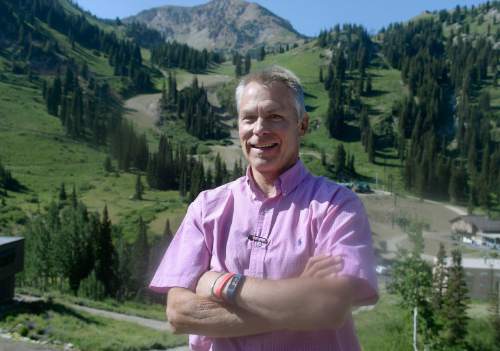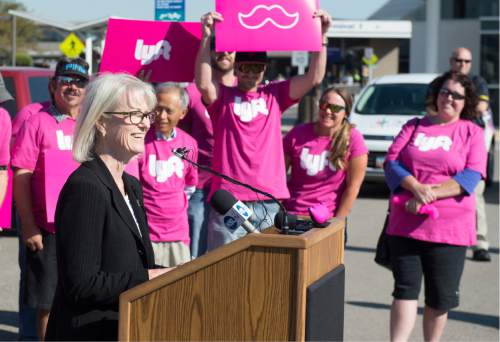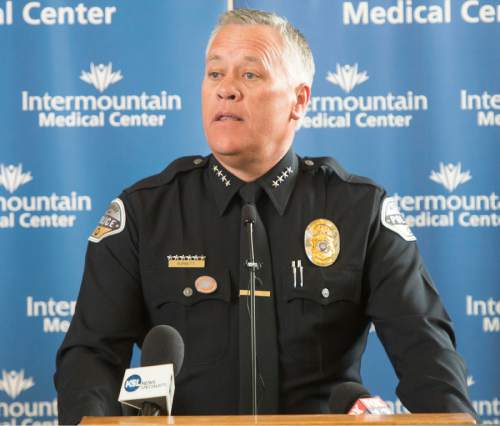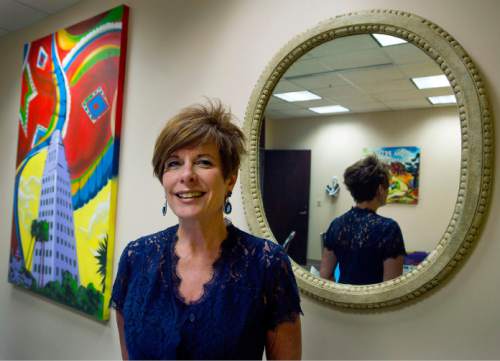This is an archived article that was published on sltrib.com in 2016, and information in the article may be outdated. It is provided only for personal research purposes and may not be reprinted.
Laboring in public service can require private sacrifice — whether dealing with a prickly populace, navigating the shifting political winds or, yes, settling for smaller salaries.
But that doesn't mean public employees are forever barred from fatter paychecks and bounteous benefits. Those at the top of the civil-service ladder can make a tidy living.
In fact, the number of city and county government employees in Salt Lake County who have reached the six-figure stratosphere has shot up by 64 percent in the past five years.
In 2011, 1,344 city and county workers made $100,000 a year in total compensation — a figure that includes salaries, bonuses, health insurance and other benefits. In 2015, that number ballooned to 2,201 employees, according to an analysis by The Salt Lake Tribune of records from Salt Lake County and its 16 cities.
Their combined compensation last year totaled $273 million.
In fact, 32 employees in 2015 made more than $200,000 a year, compared with just two in 2011.
These rising pay packages draw the ire of some watchdog groups.
"It's easier for the government to be generous with other people's money because they don't have to rely on a willing payer to pay that money to them — they take it by compulsion," said Howard Stephenson, president of the business-backed Utah Taxpayers Association. "What we have in government is an entitlement mentality."
Others are quick to note that top jobs demand high salaries if the public sector is to compete with private enterprise for the best and the brightest.
"Cities decide to pay officials what the market requires to get those officials," said Roger Tew, tax consultant for the Utah League of Cities and Towns, which advocates for municipal governments.
Female executives still lagging in pay
In 2015, women made up 41 percent of the local government workforce in Utah's most-populous county, but only 17 percent belonged to the so-called $100K club.
In Salt Lake City, the showing is even worse, with a mere 12 percent of that exclusive group being women. Not far away, in the rapidly growing West Jordan suburb, only two of the 56 employees earning at least $100,000 were women.
"These are people making public policy on our daily lives," said former state Sen. Pat Jones, CEO of the Women's Leadership Institute, which aims to infuse the state with more female leadership. "Shouldn't we have a woman's perspective in the mix?"
Of note, however, the two highest-paid local government officials last year were women:
• Maureen Riley, who pilots Salt Lake City's Department of Airports, earned $298,297 in compensation.
• Beth Overhuls, Salt Lake County's first-ever chief information officer, a technology-management position, made $258,629 in her debut year on the job.
The region has seen some growth in the number of female government officials earning six figures, rising from 13 percent five years ago to 17 percent in 2015, thanks largely to the two biggest players, Salt Lake City and Salt Lake County, more than doubling the number of women in the $100K club.
"It's something we're very aware of," said Matthew Rojas, spokesman for first-year Salt Lake City Mayor Jackie Biskupski, the capital's second female mayor. "The large gender gap is not just in pay but in the number city workers in general."
After seven months on the job, Biskupski's team has hired women in top leadership roles. Public utilities and economic development, for instance, are now headed by women.
County Mayor Ben McAdams is aware of the gender gap, as well, and has worked to close it. Fifteen of his 22 Cabinet members are women.
Experts point to numerous ways to establish gender equity in the public workplace. For starters, Jones said, women need to be as assertive as men in applying for jobs and pressing for raises. Bosses also must seek out and promote women, who then can be role models for other women.
"When a woman is applying for work, and she goes to be interviewed, and she looks on the wall at the executive leadership — if she sees pictures of 15 men and either [none] or one woman, what does that say to her? What story does that leave her?" Jones said. "If she sees a preponderance of women, she can think, 'I am included. I have a place here.' "
Airport director has the loftiest pay
Riley's spot atop the list of highest paid officials is as steady as a cruising airplane.
Since landing her job as executive director of Salt Lake City's Department of Airports in 2007 — a hire of then-Mayor Rocky Anderson — she has been earning six figures. Her 2015 compensation totaled $298,297; this year, that number soared to $354,352.
Her compensation package is typical of major airport bosses, who manage multibillion-dollar budgets and oversee advanced technical operations. Riley directs a $367 million annual budget with more than 500 employees at three airports — in Salt Lake City, West Jordan and Tooele Valley. She also is helping to steer a $2.6 billion overhaul of the international airport.
Riley's earnings are funded through fees from rental cars, concessions, parking and other profit-generating aspects of the airport.
"It's as close as you can get to a business entity in government — it generates revenue," said Natalie Gochnour, a member of the Airport Advisory Board and associate dean at the University of Utah's business school. "It's an enormously complex job that Maureen does."
Riley manages relationships with major airline partners, including Delta (with its Salt Lake City hub), United, Southwest and JetBlue. Her training in negotiation and financial skills stems from her education at the University of Pennsylvania's Wharton School and her certification in public accounting. Riley worked as a consultant specializing in financial management of construction programs before spending 13 years at Orlando International Airport.
"Something a lot of airport directors don't have is the ability to look at the bottom line, the profits and losses, and understand how to redirect money appropriately," City Council Chairman James Rogers, an Airport Board member. "We are so fortunate we have someone as competent as Maureen Riley running our airport."
In July 2014, Riley finally won buy-in from her airline partners to build a new terminal, finalizing a $2.6 billion development plan that had been in the discussion phase for nearly two decades. The undertaking, which is expected to last about 10 years, is the largest public works project in Utah history.
"Maureen sealed the deal for this city," Gochnour said.
The city also pays handsomely for its other top airport executives. John Buckner, the airport's director of administration and commercial services, made $218,311 last year in total compensation, and Kevin Robins, director of airport engineering, earned $210,457.
Welcome to the $200,000 club
Five years ago, Riley was one of two city or county employees in Salt Lake County earning more than $200,000 a year. By 2015, that number had climbed to 32.
Comprised almost entirely of city managers, attorneys, fire chiefs and police chiefs, the swelling $200K club reflects another leap in the effort to keep government jobs competitive as the economy recovers from the Great Recession.
"You can see that the private sector during the recession didn't do as well as the stability of the public sector," Rogers said. "Now, you see it's turning as the private sector gets better. In order to retain individuals, we have to be competitive with the private market."
Local governments also face another Utah reality: a growing population that will need growing public services. By 2050, the state can expect 1 million to 2.5 million additional residents, according to Utah Foundation projections. Salt Lake County alone is expected to add 630,000.
"We can't get around the fact that we're going to need more attorneys for a larger criminal-justice system, and we're going to need many more working professional staff who are compensated accordingly," said McAdams, the county mayor. "We're in a time of rapid evolution when we're looking to better harness our technology stream to see what we can do to make the county more efficient."
In coming years, the $200K club is expected to grow, human-resources experts say, to match population growth and to keep jobs competitive.
Changes at Salt Lake City Hall
Since Biskupski took over in January, Salt Lake City has seen hefty employee turnover.
After her election, she called for resignations from nearly all city department heads, replacing many of them with new officials and new compensation packages.
Longtime Director of Public Utilities Jeff Niermeyer, for example, and his $221,734 compensation were replaced by Laura Briefer and her earnings of $181,794.
"We did do an analysis during the budget process to see whether people were making at-scale market rate," said Rojas, the mayor's spokesman. "We identified some making more than market rate, and we identified some officials not making enough. We adjusted those salaries to make sure they were making at-scale."
Biskupski's office boosted the salaries of some long-standing officials. Deputy City Attorney Edward Vetter's compensation rose more than $17,000 in the past year to $185,725, and mayoral senior adviser Lynn Pace's pay package increased by $3,700 to $187,609.
The second- and third-highest paid Salt Lake City officials last year have left their posts, opening up their jobs to employees with smaller earnings. Fire Chief Kurt Cook made $37,000 more than his successor, Brian Dale, who was promoted to chief in May 2015 and plans to retire this fall from his $194,818 post. Police Chief Chris Burbank, who was forced out amid a scandal over mishandled sexual-harassment complaints, earned $21,800 more than his replacement, Mike Brown, who makes $218,115.
The mayor herself is earning $183,716 in compensation this year compared with predecessor Ralph Becker's $181,934.
Lawyers aplenty in the $100K club
Justice for all comes at a price.
The number of city and county lawyers in Salt Lake County making six figures has nearly doubled in five years to 127. What's more, these attorneys receive an average benefits package worth $43,199.
A quarter of the local city attorneys — the top lawyer job in each of county's 16 cities — now earn more than $200,000 a year. But that's a bargain, officials say, compared with what governments would have to shell out to retain private lawyers for public work.
Lawyers make an average of $12,000 more in Utah's private law firms than for Utah governments, according to the Department of Workforce Services.
"The value we give to the county is far cheaper being in-house counsel than paying outside counsel," Salt Lake County District Attorney Sim Gill said. "The value to the taxpayer is phenomenal in terms of the totality of the legal work we do."
Government attorneys and their staffs don't just prosecute criminals; they also serve as legal advisers to elected officials and defend their agencies against lawsuits. The work is equivalent to that of a fully operating law firm, Gill said, and without sufficient compensation to stay competitive, governments wouldn't be able to attract and keep the best attorneys.
Gill's office, the largest such county operation in the state, handles about 40 percent of Utah's felony prosecutions. He hopes to grow his roster from 280 to 350 employees in the next 20 years to match the expanding population.
His office is also trying to offer additional services. County attorneys, for instance, are taking on more Salt Lake City cases to take advantage of the county's mental-health, drug-abuse and other criminal-justice resources.
"It can be hard to retain attorneys because there are market forces," Gill said, "but at least for lawyers in the public sector, we can balance that with the good we provide for the public."
Private executives go public, but not for the money
Why make the leap to public service after racking up years or even decades in private enterprise?
Beth Overhuls wanted to enter a "noble industry."
As Salt Lake County's first-ever chief information officer — and the second-highest paid local government official in the county — she spent 30 years in information technology at CBS Corp. and Walt Disney Studios.
"I thought I could make a great contribution from a technology perspective," she said.
Even if public-sector pay can't match private-sector salaries, government can offer rewards beyond money.
"Local government makes more of a difference in the lives of people in the community than would the private sector," said Neil Reichenberg, executive director of the International Public Management Association for Human Resources. "That's a competitive advantage."
Government employees are also harder to fire and have the peace of mind that their organization won't go out of business anytime soon. Benefits packages can be better than those in private enterprise, too, especially pensions for longtime workers.
Besides salaries, government compensation can include perks that add up to tens of thousands of dollars. Sick leave and vacation day monies, for example, are granted to employees even if they don't actually use them. Retiring employees can take away thousands of dollars in accumulated unused days off. Salt Lake County and state government also offer a personal preference day — an extra day each year that eligible employees can take off — a perk less commonly offered in the private sector.
In Salt Lake County, salaries may lag behind the market standard, the mayor's office said, but the benefits are better.
"Government employees have received some golden handcuffs that tie them to their jobs," said Stephenson, the head of the Utah Taxpayers Association. "They'd face diminishing benefits if they were to leave."
Police and fire chiefs top the $100K compensation list
Those in top public safety roles have usually logged a decade or more working on the ground while slowly rising through the ranks. By the time they become chiefs, they've amassed salaries and benefits that outpace most public officials.
Murray Police Chief Craig Burnett, that city's highest paid official and its only member of the $200K club, attributes his $201,099 pay package to his 31 years of service.
But it's not just the chiefs who make six figures. In Salt Lake County and its 16 cities, 462 police personnel and 267 fire department employees topped $100,000 in total compensation last year.
"There's a level of training and expectation from those who are working public safety," Burnett said. "The hours and work dangers faced maybe sets that pay and compensation higher than for other employees."
That's not to say all police and fire personnel earn big paychecks. Utah firefighters have an average salary of $34,700, and police patrol officers earn $48,700 on average. Still, as essential personnel, police officers and firefighters often enjoy job stability even in tough economic times.
"Just look at what's going on today in the world — everyone is concerned about security," Reichenberg said. "Public safety tends to get treated very well when it comes to budget time in government. You can cut HR people before you cut police officers, because the police department will say if they don't have enough people, it's not safe to walk out of the house."
City managers earn more than mayors
In most cities, mayors don't run the show; city managers do.
More than half the Salt Lake Valley's mayors work part time and earn below $50,000 from their elected office.
Their full-time, unelected city managers, however, make more than $100,000.
Take David Dobbins. He earned his master's degree in public administration from Brigham Young University, then worked for Salt Lake City before coming to Draper. As the suburb's city manager, he oversees Draper's day-to-day operations.
"Unlike many other cities, Draper does not have an economic development director to handle all of the growth in the city," he explained, "so I function in that capacity as well."
Dobbins made $242,773 last year.
"City managers have the degrees and the experience that Joe Mayor or Sally City Councilwoman just simply don't have because they haven't operated a big entity like that with such a big budget," said Sterling Barker, president of the Salt Lake chapter of the Society for Human Resource Management.
"They're going to be working full time to get answers and do analysis and provide that information to the council and mayor to make the final decisions," Sterling added.
Even small-city executives make the $100K list
Every Salt Lake County city — the large and the small — is paying at least one worker $100,000 a year in total compensation.
Even Alta.
The resort town up Little Cottonwood Canyon has fewer than 500 residents, but it services about 4,000 people daily during the winter and 1,000 in the summer — visitors from the Wasatch Front and indeed the world looking to cool down in the heat or ski its famous powder when it turns cold.
"Because we are so small, we don't have a lot of money, and we have a really small staff, so I end up kind of doing everything," Town Administrator John Guldner said. "But our size isn't really representative of the giant issues we deal with."
Guldner, whose $107,350 compensation in 2015 makes him the only Alta official earning six figures, has one assistant. Together they tackle the town's day-to-day challenges.
More than 80 percent of Alta's land is owned by the federal government, Guldner said, forcing him into constant negotiations with the U.S. Forest Service.
And since the canyon provides about a fifth of the valley's water, Guldner also works closely with Salt Lake City's water district and the county's health department.
"Nobody believes we work so hard," he said, "because our town is so small."
And hardworking civil servants — if they rise to the top — can earn paychecks that are more than good enough for government work.
jcastellano@sltrib.com















